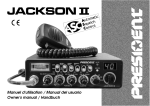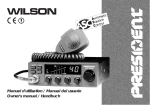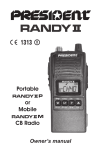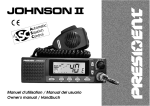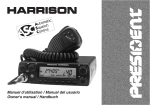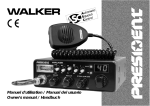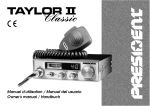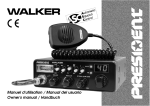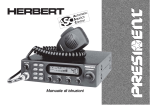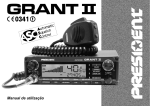Download ASC Français Espagnol Anglais Allemand.p65
Transcript
J.F.K. Manuel d'utilisation / Manual del usuario Owner's manual / Handbuch Votre PRESIDENT J.F.K. ASC en un coup d'œil Your PRESIDENT J.F.K. ASC at a glance Ihr PRESIDENT J.F.K. ASC auf einen Blick 2 is SOMMAIRE França SUMARIO ol Españ INSTALLATION 5 INSTALACIÓN 15 UTILISATION 7 UTILIZACIÓN 17 CARACTÉRISTIQUES TECHNIQUES 9 CARACTERÍSTICAS TÉCNICAS 19 GUIDE DE DÉPANNAGE 9 GUÍA DE PROBLEMAS 19 COMMENT ÉMETTRE/RECEVOIR UN MESSAGE 10 COMO EMITIR O RECIBIR UN MENSAJE 20 GLOSSAIRE 10 LÉXICO 20 GARANTIE 12 GARANTÍA 22 MODELE J.F.K. FM 43 CERTIFICADO DE ACEPTACION 41 TABLEAU DES FRÉQUENCES 46 DECLARACIÓN CE DE CONFORMIDAD 42 TABLA DE FRECUENCIAS 46 SUMMARY h English INHALTSANGABE Deutsc INSTALLATION 25 INSTALLATION 33 USE 27 BEDIENUNG 35 TECHNICAL CHARACTERISTICS 29 TECHNISCHE DATEN 37 TROUBLE SHOOTING 29 BEI PROBLEMEN 37 HOW TO TRANSMIT OR RECEIVE A MESSAGE 30 TIPS FÜR DEN FUNKVERKEHR 38 GLOSSARY 30 BEURTEILUNG DER EMPFANGSQUALITÄT 38 MODEL J.F.K. FM 44 MODELL J.F.K. FM 45 FREQUENCY TABLES 46 CB-KANÄLE UND IHRE FREQUENZEN 46 3 WARNING ! English Before using, be careful never to transmit without first having connected the antenna (connection "B" situated on the back panel of the equipment) or without having set the SWR (Standing Wave Ratio) ! Failure to do so may result in destruction of the power amplifier, which is not covered by the guarantee. The guarantee of this transceiver is valid only in the country of purchase. 24 Welcome to the world of the new generation of CB radios. The new PRESIDENT range gives you access to top performance CB equipment. With the use of up-todate technology, which guarantees unprecedented quality, your PRESIDENT J.F.K. ASC is a new step in personal communication and is the surest choice for the most demanding of professional CB radio users. To ensure that you make the most of all its capacities, we advise you to read carefully this manual before installing and using your PRESIDENT J.F.K. ASC. A) INSTALLATION: 1) WHERE AND HOW TO MOUNT YOUR MOBILE CB RADIO: c) Remember to provide for the passing and protection of different wires (e.g. power, antenna, accessory cabling) so that they do not in any way interfere with the driving of the vehicle. d) To install your equipment, use the cradle (1) and the self-tapping screws [2] provided (drilling diameter 3.2 mm). Take care not to damage the vehicle’s electrical system while drilling the dash board. e) Do not forget to insert the rubber joints [3] between the CB and its support as these have a shock-absorbing effect which permits gentle orientation and tightening of the set. f) Choose where to place the microphone support and remember that the microphone cord must stretch to the driver without interfering with the controls of the vehicle. - N.B. : As the transceiver has a frontal microphone socket, it can be set into the dash board. In this case, you will need to add an external loud speaker to improve the sound quality of communications (connector EXT.SP situated on the back panel: D). Ask your dealer for advice on mounting your CB radio. MOUNTING DIAGRAM 25 English a)You should choose the most appropriate setting from a simple and practical point of view. b) Your CB radio should not interfere with the driver or the passengers. 2) ANTENNA INSTALLATION: c) Fixed antenna: a) Choosing your antenna: - A fixed antenna should be installed in a clear a space as possible. If it is fixed to a mast, it will perhaps be necessary to stay it, according to the laws in force (you should seek professional advice). All PRESIDENT antennas and accessories are designed to give maximum efficiency to each CB radio within the range. - For CB radios, the longer the antenna, the better its results. Your dealer will be able to help you with your choice of antenna. b) Mobile antenna: 3) POWER CONNECTION: - Must be fixed to the vehicle where there is a maximum of metallic surface (ground plane), away from windscreen mountings. - If you already have a radio-telephone antenna installed, the CB antenna should be higher than this. - There are two types of antenna: pre-regulated which should be used on a good ground plane (e.g. car roof or lid of the boot), and . adjustable which offer a much larger range and can be used on a smaller ground plane (see p 27 § 5, Adjustment of SWR). - For an antenna which must be fixed by drilling, you will need a good contact between the antenna and the ground plane. To obtain this, you should lightly scratch the surface where the screw and tightening star are to be placed. - Be careful not to pinch or flatten the coaxial cable (as this runs the risk of break down and/or short circuiting). - Connect the antenna (B). Your PRESIDENT J.F.K. ASC is protected against an inversion of polarities. However, before switching it on, you are advised to check all the connections. Your equipment must be supplied with a continued current of 12 volts (A). Today, most cars and lorries are negative earth. You can check this by making sure that the negative terminal of the battery is connected either to the engine block or to the chassis. If this is not the case, you should consult your dealer. WARNING: Lorries generally have two batteries and an electrical installation of 24 volts, in which case it will be necessary to insert a 24/12 volt converter (type CV 24/12 PRESIDENT) into the electrical circuit. The following connection steps should be carried out with the power cable disconnected from the set. English a) Check that the battery is of 12 volts. b) Locate the positive and negative terminals of the battery (+ is red and - is black). Should it be necessary to lengthen the power cable, you should use the same or a superior type of cable. c) It is necessary to connect your CB to a permanent (+) and (-). We advise you to connect the power cable directly to the battery (as the connection of the Zum starter Towards starter Zum chassis Connected to chassis OUTPUT RADIUS PATTERNS 26 CB cable to the wiring of the car-radio or other parts of the electrical circuit may, in somecases, increase the likelihood of interference). d) Connect the red wire (+) to the positive terminal of the battery and the black (-) wire to the negative terminal of the battery. e) Connect the power cable to your CB radio. B) HOW TO USE YOUR CB: 1) ON/OFF - VOLUME: a) To turn the set on, turn the knob (1) clockwise b) To increase the sound level, turn the same knob further clockwise. WARNING: Never replace the original fuse (4 A) by one of a different value. 4) BASIC OPERATIONS TO BE CARRIED OUT BEFORE USING YOUR SET FOR THE FIRST TIME (without transmitting and without using the «push-to-talk» switch on the microphone): 2) ASC (Automatic Squelch Control)/SQUELCH: Suppresses undesirable back-ground noises when there are no communication. Squelch does not effect neither sound nor transmission power, but allows a considerable improvement in listening comfort. a) Connect the microphone b) Check the antenna connections c) Turn the set on by turning the knob VOLUME clockwise. d) Turn the SQUELCH knob to minimum (anti-clockwise). Adjust the volume to a comfortable level. e) Go to Channel 20 using the rotary knob on the front panel. a)MANUAL SQUELCH Turn the squelch knob clockwise to the exact point where all back-ground noise disappears. This adjustment should be done with precision as, if set to maximum, (i.e. fully clockwise) only the strongest signals will be received. The adjustment of this function is done automatically when the key (9, ASC) is activated. 5) ADJUSTMENT OF SWR (Standing wave ratio): No repetitive manual adjustment and a permanent improvement in listening comfort when this function is active. It can be disconnected by using the switch (9), in this case the manual squelch control becomes active again. * Using an external SWR meter (e.g. SWR 1 or SWR 2) or the integrated SWR meter: a) To connect the SWR meter : - Connect the SWR meter between the CB radio and the antenna as close as possible to the CB (use a maximum of 40 cm cable, type President CA 2C). b) To adjust the SWR meter: - Set the CB to channel 20. - Put the switch (17) on the SWR meter to position CAL ou FWD. - Press the «push-to-talk» switch on the microphone to transmit. - Bring the index needle to ▼ by using the calibration key (5). - Change the switch (17) to position SWR (reading of the SWR level). The reading on the V.U. meter should be as near as possible to 1. If this is not the case, readjust your antenna to obtain a reading as close as possible to 1. (An SWR reading between 1 and 1.8 is acceptable). - It will be necessary to re-calibrate the SWR meter after each adjustment of the antenna. Your CB is now ready for use. 3) MIC GAIN: Is for regulating microphone sensitivity, when using a microphone other than the one supplied with your PRESIDENT J.F.K. ASC. (pre-amplified). The normal setting of this knob is fully clockwise. 4) RF GAIN: This knob is for adjusting sensitivity during reception. For long distance communications RF GAIN should be set to maximum. RF GAIN can be reduced to avoid distortion, when your correspondent is close by and when he does not have RF POWER. The normal setting of this knob is on maximum (fully clockwise). 27 English b)ASC: Automatic Squelch Control Worldwide patent, a PRESIDENT exclusivity WARNING: This must be carried out when you use your CB radio for the first time (and whenever you re-position your antenna). The adjustment must be carried out in an obstacle-free area. 5) SWR/CAL: 10) CHANNEL SELECTOR ROTARY KNOB: Used for the calibration of the SWR meter (see «Adjustment of SWR» page 27, § 5). Turning this knob allows you to choose a channel (1-40) for transmitting and receiving. 6) TONE: 11) RX/TX: This function is used to adjust the tone during reception. Turn on to activate the function. RX indicator (green) lights when the receiver is in operation and TX indicator (red) lights when the transmitter is in operation. 7) BAND SELECTOR: 12) HI/LOW: Unused key on this version. Unused key on this version. 8) RF POWER: 13) DISPLAY: When you turn this knob fully clockwise the RF power (norm peak 4 watts) is at maximum. You should reduce transmission power when the communication is close to someone who does not have RF GAIN. The display shows the current channel. The bargraph shows the level of reception, the emitted level of power and the measured standing wave ratio. The normal setting of this knob is on maximum (fully clockwise). 9) ASC (Automatic Squelch Control) and ROGER BEEP: English a) ASC (Automatic Squelch Control) Both functions ASC and ROGER BEEP will be activated pulling (9) switch see page 27, point 2). 14) MODE: b) ROGER BEEP When you finish speaking and you release the «push-to-talk» switch to allow your correspondent to speak, a «beep» sounds. Radio CB is what is known as a «simplex» method of communication, that is to say, that you cannot listen and speak at the same time (as you can, for example, with the telephone). It was custom to say «roger» to indicate to your correspondent that you’d finished speaking and that it was his turn to talk. The word «roger» has now been replaced with a beep, hence its name, «Roger Beep». Use this key to select AM or FM. The modulation mode must correspond with that of the person with whom you communicate. A/ Amplitude Modulation (AM) is for communications in areas where there are obstacles and over medium distances. B/ Frequency Modulation (FM) is for nearby communications in flat, open areas. It gives better quality of communication (squelch adjustment needs more finesse). 28 15) CH 9/19: C) TECHNICAL CHARACTERISTICS: Channel 9/19 is automatically selected. 1) GENERAL: - 16) ANL/NB: Noise Blanker/ Automatic Noise Limiter. These filters allow the reduction of back ground noise, and some reception interferences. 17) S/RF - SWR -CAL: In the S/RF position, the meter swings proportionally to the strengh of the received signal. When transmitting, the meter indicates relative RF output power. In the "CAL" position, the SWR meter can be calibrated by adjusting the "SWR CAL" control. When in the SWR position, the standing wave ratio is measured. Channels Modulation modes Frequency ranges Antenna impedance Power supply Dimensions (in mm) Weight Accessories supplied : : : : : : : : 40 AM/FM from 26.965 MHz to 27.405 MHz 50 ohms 13.2 V 174 (L) x 211 (H) x 52 (D) 1.4 kg Microphone with support, mounting cradle, screws. - Frequency allowance - Carrier power : : - : : : : : : +/- 300 Hz 4 watts FM CW 4 watts AM PEP inferior to 4 nW (- 54 dBm) 300 Hz à 3 KHz in AM/FM inferior to 20 µW 1,0 mV 1,7 A (with modulation) 1,8 % 18) 6-PIN MICROPHONE PLUG: This plug is situated on the front panel, thereby making it easier to set the equipment into the dashboard. See the cabling diagram on page 46. 19) PTT (push to talk): Depress this knob to transmit a message and release to listen to an incoming communication. Transmission interference Audio response Emitted power in the adj. channel Microphone sensitivity Drain Modulated signal distortion 3) RECEPTION: - A) DC-POWER TERMINAL (13,2 V) B) ANTENNA CONNECTOR (SO-239) C) EXTERNAL S-METER JACK (Ø 2,5 mm) D) EXTERNAL SPEAKER JACK (8 Ω, Ø 3,5 mm) 29 Maxi. sensitivity at 20 dB sinad Frequency response Adjacent channel selectivity Maximum audio power Squelch sensitivity : : : : : - Frequency image rejection rate - Intermediate frequency rej. rate - Drain : : : 0.5 µV - 113 dBm (AM/FM) 300 Hz à 3 kHz in AM/FM 60 dB 5W minimum 0.2 µV - 120 dBm maximum 1 mV - 47 dBm 60 dB 70 dB 500 mA nominal 800 mA maximum English 2) TRANSMISSION: D) TROUBLE SHOOTING F) GLOSSARY: 1) YOUR CB RADIO WILL NOT TRANSMIT OR YOUR TRANSMISSION IS OF POOR QUALITY: Below you will find some of the most frequently used CB radio expressions. Remember this is meant for fun and that you are by no means obliged to use them. In an emergency, you should be as clear as possible. - Check that the antenna is correctly connected and that the SWR is properly adjusted. - Check that the microphone is properly plugged in. INTERNATIONAL PHONETIC ALPHABET: A B C D E F G 2) YOUR CB RADIO WILL NOT RECEIVE OR RECEPTION IS POOR: - Check that the squelch level is properly adjusted. Check that the volume is set to a comfortable listening level. Check that the microphone is properly plugged in. Check that the antenna is correctly connected and that the SWR is properly adjusted. - Check that you are using the same modulation mode as your correspondent. Alpha Bravo Charlie Delta Echo Foxtrott Golf H I J L M N O Hotel India Juliett Lima Mike November Oscar P Q R S T U V Papa Quebec Romeo Sierra Tango Uniform Victor TECHNICAL VOCABULARY: 3) YOUR CB WILL NOT LIGHT UP: English AM CB CH CW DX DW FM GMT HF LF LSB RX SSB SWR SWL SW TX UHF USB VHF - Check the power supply. - Check the connection wiring. - Check the fuse. E) HOW TO TRANSMIT OR RECEIVE A MESSAGE: Now that you have read the manual, make sure that your CB Radio is ready for use (i.e. check that your antenna is connected). Choose your channel (19, 27). Choose your mode (AM/FM) which must be the same as that of your correspondent. Press the «push-to-talk» switch and announce your message «Attention stations, transmission testing» which will allow you to check the clearness and the power of your signal. Release the switch and wait for a reply. You should receive a reply like, «Strong and clear». If you use a calling channel (19, 27) and you have established communication with someone, it is common practice to choose another available channel so as not to block the calling channel. 30 : : Amplitude Modulation : Citizen’s Band : Channel : Continuous Wave : Long Distance Liaison : Dual Watch : Frequency Modulation : Greenwich Meantime : High Frequency : Low Frequency : Lower Side Band Receiver : Single Side Band : Standing Wave Ratio : Short Wave Listening : Short Wave : CB Transceiver : Ultra High Frequency : Upper Side Band : Very High Frequency W Y Z Whiskey Yankee Zulu CB LANGUAGE: : : : : : : : : : : Blocking the channel Blue boys Break : : : Breaker Clean and green Cleaner channel Coming in loud and proud Doughnut Down and gone Down one Do you copy? DX Eighty eights Eye ball Good buddy Hammer Handle Harvey wall banger How am I hitting you? Keying the mike Kojac with a kodak Land line Lunch box Man with a gun Mayday Meat wagon : : : Flashing lights of police car Slow down Channel 1 A CB set in fixed location Policeman Speeding fine Police station Motorway Absolutely Signal from an adjacent channel interfering with the transmission Pressing the PTT switch without talking Police Used to ask permission to join a conversation A CBer wishing to join a channel Clear of police Channel with less interference : : : : : : : : : : : : : : : : : : : : Good reception Tyre Turning CB off Go to a lower channel Understand? Long distance Love and kisses CBers meeting together Fellow CBer Accelerator CBer’s nickname Dangerous driver How are you receiving me? Pressing the PTT switch without talking Police radar Telephone CB set Police radar SOS Ambulance Thief Conversation No reply Right behind you Behave yourself - police ahead Slow down Congested traffic New CBer Wind Parked police car Police radar Interchange Antenna Dumb CBer Go up one channel All over/everywhere Please give me an S-meter reading. English Advertising Back off Basement Base station Bear Bear bite Bear cage Big slab Big 10-4 Bleeding Midnight shopper : Modulation : Negative copy : Over your shoulder : Part your hair : Pull your hammer back : Rat race : Rubberbander : Sail boat fuel : Smokey dozing : Smokey with a camera : Spaghetti bowl : Stinger : Turkey : Up one : Wall to wall : What am I putting to you? : 31 41 42 DE CONFORMIDAD Balaruc, el 10 de diciembre 1996 Place, date and signature : Lugar, fecha y firma : P/O Michel FABRI GPE, ALBERT BERTRANA, Director técnico Name and title of subscriber : Nombre y titulo del firmante : pr ETS 300 680 part 1, part 2 (junio 95) is in compliance with following norms or documents : es conforme a las normas o a los documentos siguientes : Emisora CB President J.F.K. We declare, under our own responsability that the following product : Declaramos, bajo nuestra responsabilidad, que el producto : A las disposiciones de la directiva 89/336/CCE "Compatibilidad electromagnetica" DECLARACIÓN SIEGE SOCIAL/HEAD OFFICE - FRANCE Route de Sète - BP 100 - 34540 BALARUC Tél : (0)4.67.46.27.27 - Fax : (0)4.67.48.48.49 Site Internet : http://www.partal.com/president_cb/ E-mail : [email protected] S.A. CAPITAL 100.000.000 FF - SIRET 389 102 260 000 12 Model JFK FM TRANSCEIVER IN ACCORDANCE WITH THE EUROPEAN STANDARD ETS 300 135 : 40 CHANNELS, 4 W FM APPROVAL DGPT Nº 97 0303 CB 0 Addition to the service manual supplied PAGE 28: PAGE 29: 14) The function key MODE (14) doesn't function. D) TECHNICAL SPECIFICATIONS : Your transceiver is only functioning in FM mode. 1) GENERAL: PAGE 29: - Approval DGPT N° - Channels - Modulation modes 16) The function key NB/ANL (16) activates only the 2) TRANSMISSION: - Carrier power - Frequency response NB filter. : : : 97 0303 CB 0 40 FM : : 4 W FM CW 300 Hz à 3 kHz en FM : : 0.5 µV - 113 dBm (FM) 300 Hz à 3 kHz en FM 3) RECEPTION: - Maxi. sensitivity at 20 dB sinad - Frequency response 44 PRISE MICRO 6 BROCHES CONEXIÓN DEL MICRO 6 PINS 6-PIN MICROPHONE PLUG BELEGUNG DER MIKRO-FONBUCHSE (sechspolig) FREQUENCY TABLES CB-KANÄLE UND IHRE FREQUENZEN TABLEAU DES FRÉQUENCES TABLA DE FRECUENCIAS N° du canal N Canal Channel Kanal 1 2 3 4 5 6 7 8 9 10 11 12 13 14 15 16 17 18 19 20 Fréquences Frecuencia Frequency Frequenzens 26,965 MHz 26,975 MHz 26,985 MHz 27,005 MHz 27,015 MHz 27,025 MHz 27,035 MHz 27,055 MHz 27,065 MHz 27,075 MHz 27,085 MHz 27,105 MHz 27,115 MHz 27,125 MHz 27,135 MHz 27,155 MHz 27,165 MHz 27,175 MHz 27,185 MHz 27,205 MHz N° du canal N Canal Channel Kanal 21 22 23 24 25 26 27 28 29 30 31 32 33 34 35 36 37 38 39 40 Fréquences Frecuencia Frequency Frequenzens 27,215 MHz 27,225 MHz 27,255 MHz 27,235 MHz 27,245 MHz 27,265 MHz 27,275 MHz 27,285 MHz 27,295 MHz 27,305 MHz 27,315 MHz 27,325 MHz 27,335 MHz 27,345 MHz 27,355 MHz 27,365 MHz 27,375 MHz 27,385 MHz 27,395 MHz 27,405 MHz 1 2 3 4 5 6 46 Modulation RX TX Masse Alimentation Modulación RX TX Masa Alimentación Modulation RX TX Ground Power Supply Modulation RX TX Masse Stromversorgung















